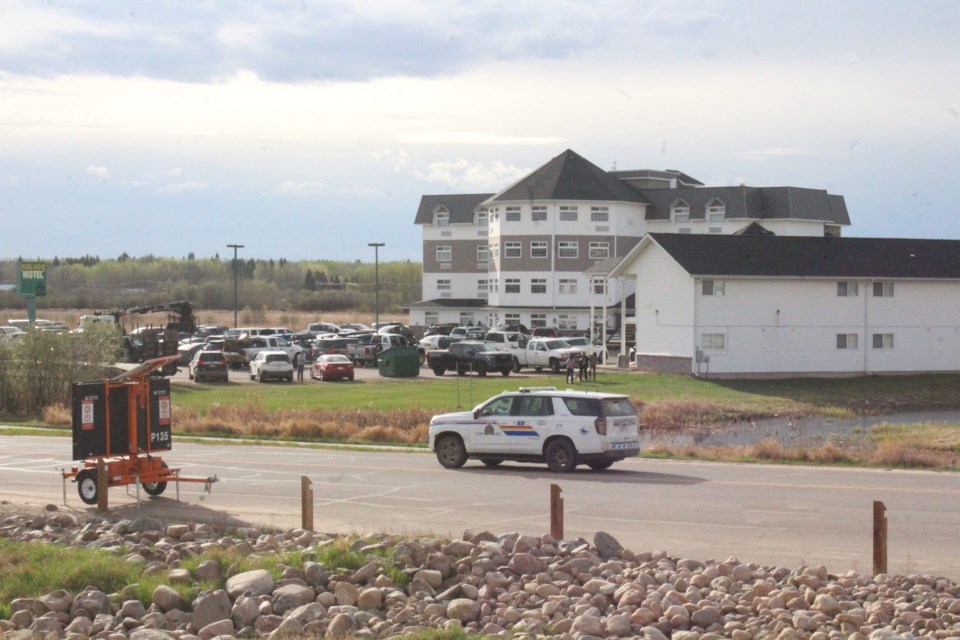LAC LA BICHE - On May 14, the parking lot of the Parkland II Motel in Lac La Biche was nearly full with vehicles of Fort McMurray residents who had been ordered to evacuate parts of the city and rural subdivisions earlier in the day due to wildfires.
Herman and Crystal Tremblay, along with their family, were part of the evacuation – again. In 2016, the couple lost their Fort McMurray home in the devastating wildfire that swept through their community. They spent more than a month in Lac La Biche and Edmonton before going back to rebuild from the charred ashes in Fort McMurray’s Beacon Hill neighbourhood.
Standing outside the Lac La Biche hotel that was seconding as an evacuation registration centre, the couple hoped this time they would return to a better outcome.
“So, we’re praying that we don’t lose it this time,” Crystal said.
She said the family had been aware of the wildfire that had been burning about 15 kilometres south of the city for a few days, and hoped they wouldn’t have to leave. That wasn’t the case.
The replay of the 2016 tragedy started with a text message on Tuesday at noon.
Crystal said the notice from the Regional Municipality of Wood Buffalo told them to go to the nearest evacuation centre, 300 kilometres south in Lac La Biche County. “We got an evacuation alert on our phone,” she told Lakeland This Week, explaining that the alert told them to register for lodgings when then arrived in Lac La Biche.
The drive south, she continued, involved heavy traffic, with many people panicking as they slowly got away from Fort McMurray. Although Crystal felt anxious along the way, she and her family were glad to get away from the danger.

Although she is once again grateful to the community for the assistance, Crystal is hopeful that her family won’t be spending any more than a couple of days in Lac La Biche. She hopes authorities can get the wildfires under control.
Arriving in Lac La Biche just a few hours after the evacuation order, Herman said the registration process was a little confusing as Lac La Biche officials were also trying to work as quickly as they could with the situation. Having been through the process before, he said the last time saw the Bold Center used as the registration centre – with a lot more space and more people working.
When the Lac La Biche Post newsroom spoke with the Tremblay family on Tuesday evening, they were waiting for a call-back from evacuation centre staff to let them know if they had a room. Herman said they were told that rooms were filling up quickly and there wasn’t a guarantee one would be available.
Later on Tuesday night, Lac La Biche evacuation centre staff said all hotel rooms in the area were booked, but campsites were open for evacuees with trailers.
With little to do but wait to see if his family could get a roof over their head for the night, Herman said his mind has been going over a lot of things. Realizing that the stress might increase his frustrations, he said he’s a little more upset this time around – upset with the fire, the process, and what he sees as a poor response to the situation. Although the fire is much smaller than the 2016 blaze that tore into his family’s life, Herman said it doesn’t take much for the flames to spread. From watching the firefight over the last week, he thinks more could have been done to knock down the flames that have again forced him to leave his home.
“They could be bombing that place with water to stop it,” he said.
According to Alberta Wildfire, resources on the fire – on the ground, in the air and preventative measures – are all in effect.
In a Wednesday morning briefing, Alberta Wildfire officials said two helicopters equipped with night-vision worked overnight Tuesday to drop water on the fire’s leading edge. By daybreak on Wednesday, there were 117 firefighters and 14 helicopters currently assigned to the wildfire. On the ground, wildland fire crews and municipal firefighters are continuing to work at establishing a containment line. Alberta Wildfire officials say helicopters and airtankers will continue to drop water and retardant on the active edges of the fire. Heavy equipment operators are also building fire guards to the southwest of Fort McMurray.
In addition, firefighters are working on structure protection in the Prairie Creek and Beacon Hill neighbourhoods. Structure protection has already been installed on the Rickards Landing Industrial Park, Gregoire Lake Estates and Gregoire Lake 176. A plan is in place for structure protection along Amoco Road, if required.
The Wednesdy morning update says that the closest point of the fire is about five kilometres from the Fort McMurray landfill and four kilometres from the intersection of highways 63 and 881.
Although the Lac La Biche region was hit with a rainstorm Tuesday night, less than a millimetre of rain fell in the Fort McMurray area overnight.
Alberta Wildfire officials say the fire will likely grow in size on Wednesday, but not as much as it did the day before. On Tuesday, the fire jumped from 11,000 hectares to 20,000, pushed towards Fort McMurray by high winds from the south and warmer temperatures.
Light winds from the northwest were forecasted for Wednesday, which fire officials say should push the fire away from Fort McMurray and Highway 63.
The Tremblay family were part of an estimated 8,000 evacuees forced to leave Fort McMurray. While Lac La Biche hotels filled up quickly, accommodations were also made available in Cold Lake and other communities across the northeast.
Following the 2016 wildfire, Lac La Biche County claimed more than $1 million from the provincial government’s disaster repayment fund for costs associated with staffing and supplies.


